A Multi-Method Approach for Deciphering Rockshelter Microstratigraphies—The Role of the Sodicho Rockshelter (SW Ethiopia) as a Geoarchaeological Archive
Abstract
:1. Introduction
2. The Site: Setting and Background
3. Material
4. Results
4.1. Micromorphology
4.1.1. Unit IX
4.1.2. Unit VIII
4.1.3. Unit VII
4.1.4. Unit VI
4.1.5. Unit V
4.1.6. Unit IV
4.1.7. Unit III
4.1.8. Unit II
4.1.9. Unit I
4.2. Black Carbon Contents and Quality
4.2.1. Profile F35
4.2.2. Profile G35
4.3. Phytoliths
- The dominance of light phytoliths: Within the samples SOD_002, SOD_027, SOD_060, SOD_103, SOD_106, and SOD_18_03, the light phytoliths dominate, with a rough ratio of ~80:20% of light to dark. The samples originate from geogenic but also anthropogenic sediment units (Units I, IV, VI, VII, VIII). The most common morphotype within the light phytoliths is Elongate;
- Roughly balanced: A rather balanced ratio of ~50:50% (±10%) between light and dark types can be found in the samples SOD_006, SOD_013, SOD_018, SOD_039, SOD_050, SOD_071, SOD_081, and SOD_096. These samples originate primarily from anthropogenic units (III, VII, VIII) and the archaeologically sterile unit (VI). Except for the two samples from Unit III, in which the dark morphotypes are relatively evenly distributed, the Elongate morphotype is most common in the other samples, followed by the Acute type;
- The dominance of dark phytoliths: Dark phytoliths, with the three morphotypes equally represented, dominate with a relative ratio of ~5:95% light to dark within the samples SOD_009, SOD_025, SOD_031, and SOD_087. The highest values are found within the anthropogenic sediment Units III and V, followed by a sample from the lower part of the sterile Unit VI. Remarkable is also a high proportion within a geogenic layer that can be associated with the middle section of tephra IV (SOD_025).
4.4. Metals in Ammonium Oxalate Extract
5. Discussion
5.1. Processes of Sediment Accumulation and Post-Depositional Alteration
5.2. Human Behavior and Fire Activity at Sodicho
6. Conclusions
Supplementary Materials
Author Contributions
Funding
Institutional Review Board Statement
Data Availability Statement
Acknowledgments
Conflicts of Interest
Appendix A. Methods
A.1. Micromorphology
A.2. Fire Residue (Black Carbon) Analysis
A.3. Phytoliths
- Deflocculation with EDTA;
- Sieving for removal of coarse sediment and modern plant remains;
- Clay removal with Stroke’s Law gravity separation;
- Carbonate destruction using HCl;
- Organic matter removal with HNO3 and KClO3;
- Heavy liquid separation with sodium polytungstate.
- Elongate (Elo): Rectilinear phytoliths with variable sizes and edges (entire, sinuate, etc.). These phytoliths were observed as single-celled or articulated;
- Blocky (Blo): Compact phytoliths with length/width <2 and equal width and thickness;
- Acute Bulbosus (Acu_Bul): Unarticulated phytoliths with a wider antapex that narrows down to an acute apex.
A.4. Ammonium Oxalate Extractable Fe, Mn, Al, and Si
Appendix B. Results
| Profile F35 | |||||||
|---|---|---|---|---|---|---|---|
| Sample ID | Depth (m b.s.) | Unit | BC (g kg−1) | STD | B5CA/B6CA | STD | |
| BC1 | 0.07 | I | 0.84 | 0.08 | 0.95 | 0.05 | |
| BC2 | 0.20 | II | 0.35 | 0.05 | 0.77 | 0.08 | |
| BC3 | 0.31 | III | 1.34 | 0.27 | 1.03 | 0.25 | |
| BC4 | 0.40 | III | 0.02 | 0.00 | 1.36 | 0.25 | excl. |
| BC5 | 0.45 | III | 0.42 | 0.08 | 0.89 | 0.00 | |
| BC6 | 0.52 | IV | 0.14 | 0.04 | 1.12 | 0.03 | |
| BC7 | 0.67 | V | 0.07 | 0.00 | 1.95 | 1.13 | excl. |
| BC8 | 0.73 | V | 1.53 | 0.44 | 1.31 | 0.42 | |
| BC9 | 0.76 | V | 0.0033 | 0.00 | 1.67 | 0.00 | excl. |
| BC10 | 0.93 | VI | 0.24 | 0.06 | 0.79 | 0.12 | |
| BC11 | 1.20 | VI | 0.24 | 0.03 | 0.59 | 0.07 | |
| BC12 | 1.43 | VI | 0.23 | 0.01 | 0.97 | 0.10 | |
| BC13 | 1.62 | VII | 0.11 | 0.00 | 1.28 | 0.67 | |
| Profile G35 | |||||||
| Sample ID | Depth (m b.s.) | Unit | BC (g kg−1) | STD | B5CA/B6CA | STD | |
| BC14 | 1.59 | VII | 0.89 | 0.08 | 0.78 | 0.02 | |
| BC15 | 1.66 | VII | 0.97 | 0.17 | 0.84 | 0.08 | |
| BC16 | 1.77 | VII | 0.17 | 0.02 | 1.78 | 0.98 | excl. |
| BC17 | 1.85 | VII | 0.48 | 0.08 | 0,.77 | 0.11 | |
| BC18 | 1.92 | VII | 0.23 | 0.00 | 0.76 | 0.13 | |
| BC19 | 1.93 | VIII | 0.21 | 0.01 | 0.85 | 0.08 | |
| BC20 | 2.00 | IX | 0.52 | 0.10 | 0.79 | 0.12 | |
| Profile F35 | |||||||||||
|---|---|---|---|---|---|---|---|---|---|---|---|
| Sample ID | Depth (m b.s.) | Unit | Blo light | Elo light | Acu_Bul light | Blo dark | Elo dark | Acu_Bul dark | Sum | % light | % dark |
| SOD_002 | 0.03 | I | 30 | 250 | 10 | 9 | 13 | 3 | 315 | 92.1 | 7.9 |
| SOD_006 | 0.13 | II | 44 | 146 | 20 | 42 | 52 | 22 | 326 | 64.4 | 35.6 |
| SOD_009 | 0.19 | III | 2 | 3 | 1 | 105 | 117 | 104 | 335 | 1.8 | 98.2 |
| SOD_013 | 0.27 | III | 26 | 94 | 29 | 91 | 43 | 29 | 312 | 47.8 | 52.2 |
| SOD_018 | 0.37 | III | 20 | 108 | 14 | 78 | 68 | 28 | 316 | 44.9 | 55.1 |
| SOD_025 | 0.51 | IV | 5 | 25 | 2 | 124 | 95 | 71 | 322 | 9.9 | 90.1 |
| SOD_027 | 0.55 | IV | 25 | 210 | 13 | 12 | 38 | 13 | 310 | 79.7 | 20.3 |
| SOD_031 | 0.63 | V | 3 | 3 | 1 | 133 | 117 | 83 | 340 | 2.1 | 97.9 |
| SOD_039 | 0.79 | VI | 32 | 158 | 23 | 18 | 82 | 37 | 350 | 60.9 | 39.1 |
| SOD_050 | 1.01 | VI | 33 | 121 | 14 | 28 | 106 | 72 | 374 | 44.9 | 55.1 |
| SOD_060 | 1.21 | VI | 15 | 220 | 36 | 11 | 41 | 25 | 348 | 77.9 | 22.1 |
| SOD_071 | 1.43 | VI (VII) | 44 | 98 | 16 | 38 | 71 | 66 | 333 | 47.4 | 52.6 |
| SOD_081 | 1.63 | VII | 32 | 78 | 14 | 30 | 83 | 67 | 310 | 40.3 | 59.7 |
| Profile G35 | |||||||||||
| Sample ID | Depth (m b.s.) | Unit | Blo light | Elo light | Acu_Blo light | Blo dark | Elo dark | Acu_Blo dark | Sum | % light | % dark |
| SOD_087 | 1.44 | VI (VII) | 5 | 8 | 3 | 117 | 170 | 113 | 416 | 3.8 | 96.2 |
| SOD_096 | 1.62 | VII | 28 | 138 | 11 | 22 | 84 | 55 | 338 | 52.4 | 47.6 |
| SOD_103 | 1.8 | VII | 20 | 257 | 22 | 9 | 20 | 16 | 344 | 86.9 | 13.1 |
| SOD_106 | 1.86 | VII | 10 | 253 | 18 | 2 | 12 | 9 | 303 | 92.7 | 7.3 |
| SOD_18_03 | 1.96 | VIII | 11 | 223 | 19 | 5 | 32 | 16 | 306 | 82.7 | 17.3 |
| SOD_18_07 | 2.04 | IX | n.c. | n.c. | n.c. | n.c. | n.c. | n.c. | n.c. | n.c. | n.c. |
| Profile F35 | |||||||||||
|---|---|---|---|---|---|---|---|---|---|---|---|
| Depth | AlO | AlO s | FeO | FeO s | MnO | MnO s | SiO | SiO s | |||
| Sample ID | (m b.s.) | Unit | (g kg−1) | (g kg−1) | (g kg−1) | (g kg−1) | (g kg−1) | (g kg−1) | (g kg−1) | (g kg−1) | AlO:SiO |
| SOD_003 | 0.06 | I | 1.91 | 0.07 | 5.97 | 0.23 | 1.20 | 0.19 | 0.93 | 0.02 | 2.06 |
| SOD_007 | 0.15 | II | 0.77 | 0.03 | 1.84 | 0.15 | 0.44 | 0.00 | 0.31 | 0.02 | 2.47 |
| SOD_009 | 0.19 | III | 9.45 | 0.26 | 4.98 | 0.02 | 1.77 | 0.01 | 2.76 | 0.05 | 3.42 |
| SOD_015 | 0.31 | III | 0.84 | 0.02 | 1.87 | 0.03 | 0.66 | 0.01 | 0.37 | 0.01 | 2.26 |
| SOD_018 | 0.37 | III | 1.40 | 0.07 | 2.98 | 0.26 | 1.05 | 0.11 | 0.55 | 0.04 | 2.53 |
| SOD_025 | 0.51 | IV | 0.90 | 0.12 | 1.77 | 0.24 | 0.92 | 0.17 | 0.39 | 0.06 | 2.29 |
| SOD_029 | 0.59 | V | 7.00 | 0.39 | 4.80 | 0.37 | 2.77 | 0.10 | 2.32 | 0.28 | 3.02 |
| SOD_031 | 0.63 | V | 17.07 | 0.45 | 5.25 | 0.39 | 2.23 | 0.17 | 5.96 | 0.42 | 2.86 |
| SOD_036 | 0.73 | V/VI | 1.92 | 0.03 | 3.21 | 0.18 | 0.51 | 0.01 | 0.67 | 0.03 | 2.87 |
| SOD_044 | 0.89 | VI | 2.07 | 0.08 | 7.66 | 0.16 | 0.89 | 0.15 | 1.02 | 0.00 | 2.03 |
| SOD_051 | 1.03 | VI | 2.17 | 0.11 | 8.15 | 0.96 | 0.64 | 0.09 | 1.06 | 0.10 | 2.06 |
| SOD_054 | 1.09 | VI | 2.08 | 0.05 | 5.41 | 0.27 | 0.68 | 0.06 | 0.86 | 0.05 | 2.42 |
| SOD_061 | 1.23 | VI | 1.98 | 0.15 | 6.24 | 0.76 | 0.64 | 0.13 | 0.91 | 0.11 | 2.17 |
| SOD_078 | 1.57 | VII | 1.70 | 0.04 | 5.26 | 0.10 | 0.80 | 0.09 | 0.77 | 0.03 | 2.20 |
| SOD_083 | 1.68 | VII | 2.85 | 0.11 | 5.30 | 0.14 | 2.26 | 0.06 | 1.03 | 0.04 | 2.76 |
| Profile G35 | |||||||||||
| Depth | Alo | Alo s | Feo | Feo s | Mno | Mno s | Sio | Sio s | |||
| Sample ID | (m b.s.) | Unit | (g kg−1) | (g kg−1) | (g kg−1) | (g kg−1) | (g kg−1) | (g kg−1) | (g kg−1) | (g kg−1) | AlO:SiO |
| SOD_086 | 1.41 | VI | 2.23 | 0.11 | 7.98 | 0.57 | 0.80 | 0.09 | 1.25 | 0.09 | 1.78 |
| SOD_102 | 1.78 | VII | 1.39 | 0.01 | 3.40 | 0.11 | 1.74 | 0.02 | 0.59 | 0.01 | 2.37 |
| SOD_18_01 | 1.92 | VII | 1.47 | 0.06 | 3.56 | 0.30 | 1.00 | 0.11 | 0.56 | 0.05 | 2.64 |
| SOD_18_04 | 1.98 | VIII | 1.57 | 0.11 | 3.77 | 0.33 | 1.24 | 0.15 | 0.59 | 0.05 | 2.68 |
| SOD_18_07 | 2.04 | IX | 1.56 | 0.07 | 3.96 | 0.09 | 1.37 | 0.03 | 0.53 | 0.02 | 2.96 |
References
- Hensel, E.A.; Vogelsang, R.; Noack, T.; Bubenzer, O. Stratigraphy and Chronology of Sodicho Rockshelter–A New Sedimentological Record of Past Environmental Changes and Human Settlement Phases in Southwestern Ethiopia. Front. Earth Sci. 2021, 8. [Google Scholar] [CrossRef]
- Brandt, S.A.; Fisher, E.C.; Hildebrand, E.A.; Vogelsang, R.; Ambrose, S.H.; Lesur, J.; Wang, H. Early MIS 3 occupation of Mochena Borago Rockshelter, Southwest Ethiopian Highlands: Implications for Late Pleistocene archaeology, paleoenvironments and modern human dispersals. Quat. Int. 2012, 274, 38–54. [Google Scholar] [CrossRef]
- Brandt, S.; Hildebrand, E.; Vogelsang, R.; Wolfhagen, J.; Wang, H. A new MIS 3 radiocarbon chronology for Mochena Borago Rockshelter, SW Ethiopia: Implications for the interpretation of Late Pleistocene chronostratigraphy and human behavior. J. Archaeol. Sci. Rep. 2017, 11, 352–369. [Google Scholar] [CrossRef] [Green Version]
- Vogelsang, R.; Wendt, K.P. Reconstructing prehistoric settlement models and land use patterns on Mt. Damota/SW Ethiopia. Quat. Int. 2018, 485, 140–149. [Google Scholar] [CrossRef]
- Waters, M.R. Principles of Geoarchaeology: A North American Perspective; University of Arizona Press: Tucson, AZ, USA, 1992; ISBN 0-8165-1770-3. [Google Scholar]
- Churchman, G.J.; Lowe, D.J. Alteration, Formation, and Occurrence of Minerals in Soils. In Handbook of Soil Sciences: Properties and Processes; CRC Press: Boca Raton, FL, USA, 2012; pp. 1–72. [Google Scholar]
- Stoops, G.; Nicosia, C. Introduction. In Archaeological Soil and Sediment Micromorphology; Nicosia, C., Stoops, G., Eds.; John Wiley & Sons, Ltd.: Chichester, UK, 2017; pp. 1–5. [Google Scholar]
- Mark, B.G.; Osmaston, H.A. Quaternary glaciation in Africa: Key chronologies and climatic implications. J. Quat. Sci. 2008, 23, 589–608. [Google Scholar] [CrossRef]
- Junginger, A.; Trauth, M.H. Hydrological constraints of paleo-Lake Suguta in the Northern Kenya Rift during the African Humid Period (15–5kaBP). Glob. Planet. Chang. 2013, 111, 174–188. [Google Scholar] [CrossRef]
- Stoops, G. Guidelines for Analysis and Description of Soil and Regolith Thin Sections; John Wiley & Sons: Hoboken, NJ, USA, 2021; Volume 184. [Google Scholar]
- Goldberg, P.; Miller, C.E.; Schiegl, S.; Ligouis, B.; Berna, F.; Conard, N.J.; Wadley, L. Bedding, hearths, and site maintenance in the Middle Stone Age of Sibudu Cave, KwaZulu-Natal, South Africa. Archaeol. Anthropol. Sci. 2009, 1, 95–122. [Google Scholar] [CrossRef] [Green Version]
- Marean, C.W.; Bar-Matthews, M.; Fisher, E.; Goldberg, P.; Herries, A.; Karkanas, P.; Nilssen, P.J.; Thompson, E. The stratigraphy of the Middle Stone Age sediments at Pinnacle Point Cave 13B (Mossel Bay, Western Cape Province, South Africa). J. Hum. Evol. 2010, 59, 234–255. [Google Scholar] [CrossRef]
- Miller, C.E.; Goldberg, P.; Berna, F. Geoarchaeological investigations at Diepkloof Rock Shelter, Western Cape, South Africa. J. Archaeol. Sci. 2013, 40, 3432–3452. [Google Scholar] [CrossRef]
- Inglis, R.H.; French, C.; Farr, L.; Hunt, C.O.; Jones, S.; Reynolds, T.; Barker, G. Sediment micromorphology and site formation processes during the Middle to Later Stone Ages at the Haua Fteah Cave, Cyrenaica, Libya. Geoarchaeology 2017, 33, 328–348. [Google Scholar] [CrossRef]
- Klasen, N.; Kehl, M.; Mikdad, A.; Brückner, H.; Weniger, G.-C. Chronology and formation processes of the Middle to Upper Palaeolithic deposits of Ifri n’Ammar using multi-method luminescence dating and micromorphology. Quat. Int. 2018, 485, 89–102. [Google Scholar] [CrossRef]
- Potì, A.; Kehl, M.; Broich, M.; Marco, Y.C.; Hutterer, R.; Jentke, T.; Linstädter, J.; López-Sáez, J.A.; Mikdad, A.; Morales, J.; et al. Human occupation and environmental change in the western Maghreb during the Last Glacial Maximum (LGM) and the Late Glacial. New evidence from the Iberomaurusian site Ifri El Baroud (northeast Morocco). Quat. Sci. Rev. 2019, 220, 87–110. [Google Scholar] [CrossRef]
- Goldberg, P.; Bar-Yosef, O. Site Formation Processes in Kebara and Hayonim Caves and Their Significance in Levantine Pre-historic Caves. In Neandertals and Modern Humans in Western Asia; Akazawa, T., Aoki, K., Bar-Yosef, O., Eds.; Springer: Boston, MA, USA, 2005; pp. 107–125. [Google Scholar]
- Albert, R.M.; Berna, F.; Goldberg, P. Insights on Neanderthal fire use at Kebara Cave (Israel) through high resolution study of prehistoric combustion features: Evidence from phytoliths and thin sections. Quat. Int. 2012, 247, 278–293. [Google Scholar] [CrossRef]
- Kehl, M.; Burow, C.; Cantalejo, P.; Domínguez-Bella, S.; Durán, J.J.; Henselowsky, F.; Klasen, N.; Linstädter, J.; Medianero, J.; Pastoors, A.; et al. Site formation and chronology of the New Paleolithic Site Sima de Las Palomas de Teba, Southern Spain. Quat. Res. 2016, 85, 313–331. [Google Scholar] [CrossRef]
- Miller, C.E. A Tale of Two Swabian Caves: Geoarchaeological Investigations at Hohle Fels and Geißenklösterle; Kerns Verlag: Tübingen, Germany, 2015; ISBN 3-935751-19-2. [Google Scholar]
- Whitau, R.; Vannieuwenhuyse, D.; Dotte-Sarout, E.; Balme, J.; O’Connor, S. Home Is Where the Hearth Is: Anthracological and Microstratigraphic Analyses of Pleistocene and Holocene Combustion Features, Riwi Cave (Kimberley, Western Australia). J. Archaeol. Method Theory 2018, 25, 739–776. [Google Scholar] [CrossRef] [PubMed] [Green Version]
- Brancaleoni, G.; Shnaider, S.; Osipova, E.; Danukalova, G.; Kurbanov, R.; Deput, E.; Kyzy, S.A.; Abdykanova, A.; Krajcarz, M.T. Depositional history of a talus cone in an arid intermontane basin in Central Asia: An interdisciplinary study at the Late Pleistocene–Late Holocene Obishir-I site, Kyrgyzstan. Geoarchaeology 2021, 1–24. [Google Scholar] [CrossRef]
- Morley, M.W.; Goldberg, P.; Uliyanov, V.A.; Kozlikin, M.B.; Shunkov, M.V.; Derevianko, A.P.; Jacobs, Z.; Roberts, R.G. Hominin and animal activities in the microstratigraphic record from Denisova Cave (Altai Mountains, Russia). Sci. Rep. 2019, 9, 13785. [Google Scholar] [CrossRef] [PubMed]
- Kolobova, K.A.; Roberts, R.G.; Chabai, V.P.; Jacobs, Z.; Krajcarz, M.T.; Shalagina, A.V.; Krivoshapkin, A.I.; Li, B.; Uthmeier, T.; Markin, S.V.; et al. Archaeological evidence for two separate dispersals of Neanderthals into southern Siberia. Proc. Natl. Acad. Sci. USA 2020, 117, 2879–2885. [Google Scholar] [CrossRef] [PubMed] [Green Version]
- Goldberg, E.D. Black Carbon in the Environment: Properties and Distribution; John Wiley and Sons: New York, NY, USA, 1985. [Google Scholar]
- Schmidt, M.W.I.; Noack, A.G. Black carbon in soils and sediments: Analysis, distribution, implications, and current challenges. Glob. Biogeochem. Cycles 2000, 14, 777–793. [Google Scholar] [CrossRef]
- Keiluweit, M.; Nico, P.S.; Johnson, M.G.; Kleber, M. Dynamic Molecular Structure of Plant Biomass-Derived Black Carbon (Biochar). Environ. Sci. Technol. 2010, 44, 1247–1253. [Google Scholar] [CrossRef] [Green Version]
- Masiello, C.A.; Druffel, E.R.M. Black Carbon in Deep-Sea Sediments. Science 1998, 280, 1911–1913. [Google Scholar] [CrossRef] [PubMed] [Green Version]
- Scott, A.C.; Glasspool, I.J. The diversification of Paleozoic fire systems and fluctuations in atmospheric oxygen concentration. Proc. Natl. Acad. Sci. USA 2006, 103, 10861–10865. [Google Scholar] [CrossRef] [PubMed] [Green Version]
- Wolf, M.; Lehndorff, E.; Mrowald, M.; Eckmeier, E.; Kehl, M.; Frechen, M.; Pätzold, S.; Amelung, W. Black carbon: Fire fingerprints in Pleistocene loess–palaeosol archives in Germany. Org. Geochem. 2014, 70, 44–52. [Google Scholar] [CrossRef]
- Brodowski, S.; Rodionov, A.; Haumaier, L.; Glaser, B.; Amelung, W. Revised black carbon assessment using benzene polycarboxylic acids. Org. Geochem. 2005, 36, 1299–1310. [Google Scholar] [CrossRef]
- Glaser, B.; Haumaier, L.; Guggenberger, G.; Zech, W. Black carbon in soils: The use of benzenecarboxylic acids as specific markers. Org. Geochem. 1998, 29, 811–819. [Google Scholar] [CrossRef]
- Wolf, M.; Lehndorff, E.; Wiesenberg, G.; Stockhausen, M.; Schwark, L.; Amelung, W. Towards reconstruction of past fire regimes from geochemical analysis of charcoal. Org. Geochem. 2013, 55, 11–21. [Google Scholar] [CrossRef] [Green Version]
- Vrydaghs, L.; Devos, Y.; Pető, Á. Opal Phytoliths. In Archaeological Soil and Sediment Micromorphology; John Wiley & Sons, Ltd.: Chichester, UK, 2017; pp. 155–163. [Google Scholar]
- Kaczorek, D.; Vrydaghs, L.; Devos, Y.; Petó, Á.; Effland, W.R. Biogenic Siliceous Features. In Interpretation of Micromorphological Features of Soils and Regoliths, 2nd ed.; Stoops, G., Marcelino, V., Mees, F., Eds.; Elsevier: Amsterdam, The Netherlands; Oxford, UK, 2018; pp. 157–176. ISBN 978-0-444-63522-8. [Google Scholar]
- Neumann, K.; Strömberg, C.A.E.; Ball, T.; Albert, R.M.; Vrydaghs, L.; Cummings, L.S. International Code for Phytolith Nomenclature (ICPN) 2.0. Ann. Bot. 2019, 124, 189–199. [Google Scholar] [CrossRef]
- Parr, J.F. Effect of fire on phytolith coloration. Geoarchaeology 2006, 21, 171–185. [Google Scholar] [CrossRef]
- Tamm, O. Über ie Oxalatmethode in der chemischen Bodenanalyse. Med. Följer Skogsvärdsföreningens Tidskr. 1932, 27, 1–20. [Google Scholar]
- Schwertmann, U. Der einfluss einfacher organischer anionen auf die bildung von goethit und hämatit aus amorphen Fe(III)-Hydroxid. Geoderma 1970, 3, 207–214. [Google Scholar] [CrossRef]
- Rennert, T. Wet-chemical extractions to characterise pedogenic Al and Fe species–A critical review. Soil Res. 2019, 57, 1–16. [Google Scholar] [CrossRef]
- Woldegabriel, G.; Aronson, J.L.; Walter, R. Geology, geochronology, and rift basin development in the central sector of the Main Ethiopia Rift. GSA Bull. 1990, 102, 439–458. [Google Scholar] [CrossRef]
- WoldeGabriel, G.; Walter, R.C.; Aronson, J.L.; Hart, W.K. Geochronology and distribution of silicic volcanic rocks of Plio-Pleistocene age from the central sector of the Main Ethiopian Rift. Quat. Int. 1992, 13–14, 69–76. [Google Scholar] [CrossRef]
- Chernet, T. Geology and hydrothermal resources in the northern Lake Abaya area (Ethiopia). J. Afr. Earth Sci. 2011, 61, 129–141. [Google Scholar] [CrossRef]
- Hensel, E.A.; Bödeker, O.; Bubenzer, O.; Vogelsang, R. Combining geomorphological–hydrological analyses and the location of settlement and raw material sites–A case study on understanding prehistoric human settlement activity in the southwestern Ethiopian Highlands. E&G Quat. Sci. J. 2019, 68, 201–213. [Google Scholar] [CrossRef]
- Berhanu, B.; Melesse, A.M.; Seleshi, Y. GIS-based hydrological zones and soil geo-database of Ethiopia. Catena 2013, 104, 21–31. [Google Scholar] [CrossRef]
- IUSS Working Group WRB. World Reference Base for Soil Resources 2014: International Soil Classification System for Naming Soils and Creating Legends for Soil Maps; FAO: Rome, Italy, 2015; Volume 106. [Google Scholar]
- Gutherz, X.; Jallot, L.; Lesur, J.; Pouzolles, G.; Sordoillet, D. Les fouilles de l’abri sous-roche de Moche Borago (Soddo-Wolayta). Premier bilan. Ann. D’ethiopie 2002, 18, 181–190. [Google Scholar] [CrossRef]
- Fisher, E.C. Late Pleistocene Technological Change and Hunter Gatherer Behavior at Moche Borago Rockshelter, Sodo-Wolayta, Ethiopia: Flaked Stone Artifacts from the Early OIS 3 (60–43 Ka) Deposits. Ph.D. Thesis, University of Florida, Gainesville, FL, USA, 2010. [Google Scholar]
- Mentzer, S.M. Microarchaeological Approaches to the Identification and Interpretation of Combustion Features in Prehistoric Archaeological Sites. J. Archaeol. Method Theory 2014, 21, 616–668. [Google Scholar] [CrossRef]
- Stoops, G.; Sedov, S.; Shoba, S. Regoliths and Soils on Volcanic Ash. In Interpretation of Micromorphological Features of Soils and Regoliths, 2nd ed.; Elsevier: Amsterdam, The Netherlands; Oxford, UK, 2018; pp. 721–751. [Google Scholar]
- Parfitt, R.L.; Furkert, R.J.; Henmi, T. Identification and Structure of Two Types of Allophane from Volcanic Ash Soils and Tephra. Clays Clay Miner. 1980, 28, 328–334. [Google Scholar] [CrossRef]
- Farmer, V.C.; McHardy, W.J.; Robertson, L.; Walker, A.; Wilson, M.J. Micromorphology and sub-microscopy of allophane and imogolite in a podzol Bs horizon: Evidence for translocation and origin. J. Soil Sci. 1985, 36, 87–95. [Google Scholar] [CrossRef]
- Churchman, G.J.; Velde, B. Soil Clays: Linking Geology, Biology, Agriculture, and the Environment; CRC Press: Boca Raton, FL, USA, 2019; ISBN 0-429-53224-5. [Google Scholar]
- Gillhuber, S.; Lehrberger, G.; Thuro, K. Teplá Trachyte Weathering Phenomena and Physical Properties of a Rare Volcanogenic Building Stone. Geol. Soc. Lond. 2006, 469, 1–11. [Google Scholar]
- Foerster, V.; Junginger, A.; Langkamp, O.; Gebru, T.; Asrat, A.; Umer, M.; Lamb, H.F.; Wennrich, V.; Rethemeyer, J.; Nowaczyk, N.; et al. Climatic change recorded in the sediments of the Chew Bahir basin, southern Ethiopia, during the last 45,000 years. Quat. Int. 2012, 274, 25–37. [Google Scholar] [CrossRef]
- Foerster, V.; Vogelsang, R.; Junginger, A.; Asrat, A.; Lamb, H.; Schaebitz, F.; Trauth, M. Environmental change and human occupation of southern Ethiopia and northern Kenya during the last 20,000 years. Quat. Sci. Rev. 2015, 129, 333–340. [Google Scholar] [CrossRef] [Green Version]
- Hildebrand, E.A.; Brandt, S.A.; Friis, I.; Demissew, S. Paleoenvironmental Reconstructions for the Horn of Africa: Interdisciplinary Perspectives on Strategy and Significance. In Trees, Grasses and Crops. People and Plants in Sub-saharan Africa and Beyond; Verlag Dr. Rudolf Habelt: Bonn, Germany, 2019; pp. 187–210. ISBN 3-7749-4221-8. [Google Scholar]
- Trauth, M.H.; Asrat, A.; Duesing, W.; Foerster, V.; Kraemer, K.H.; Marwan, N.; Maslin, M.; Schaebitz, F. Classifying past climate change in the Chew Bahir basin, southern Ethiopia, using recurrence quantification analysis. Clim. Dyn. 2019, 53, 2557–2572. [Google Scholar] [CrossRef] [Green Version]
- Chadwick, O.A.; Gavenda, R.T.; Kelly, E.F.; Ziegler, K.; Olson, C.G.; Elliott, W.; Hendricks, D.M. The impact of climate on the biogeochemical functioning of volcanic soils. Chem. Geol. 2003, 202, 195–223. [Google Scholar] [CrossRef]
- Parfitt, R.; Henmi, T. Comparison of an oxalate-extraction methon and an infrared spectroscopic method for determining allophane in soll clays. Soil Sci. Plant Nutr. 1982, 28, 183–190. [Google Scholar] [CrossRef] [Green Version]
- Stoops, G.; Marcelino, V. Lateritic and Bauxitic Materials. In Interpretation of Micromorphological Features of Soils and Regoliths, 2nd ed.; Stoops, G., Marcelino, V., Mees, F., Eds.; Elsevier: Amsterdam, The Netherlands; Oxford, UK, 2018; pp. 691–720. [Google Scholar]
- Kühn, P.; Aguilar, J.; Miedema, R.; Bronnikova, M. Textural Pedofeatures and Related Horizons. In Interpretation of Micromorphological Features of Soils and Regoliths, 2nd ed.; Stoops, G., Marcelino, V., Mees, F., Eds.; Elsevier: Amsterdam, The Netherlands; Oxford, UK, 2018; pp. 377–423. ISBN 978-0-444-63522-8. [Google Scholar]
- Karkanas, P. Chemical Alteration. In Encyclopedia of Geoarchaeology; Gilbert, A.S., Ed.; Springer: Dordrecht, The Netherlands, 2017; pp. 129–138. ISBN 978-1-4020-4409-0. [Google Scholar]
- Stoops, G.; Mees, F. Groundmass Composition and Fabric. In Interpretation of Micromorphological Features of Soils and Regoliths, 2nd ed.; Stoops, G., Marcelino, V., Mees, F., Eds.; Elsevier: Amsterdam, The Netherlands; Oxford, UK, 2018; pp. 73–125. [Google Scholar]
- Vepraskas, M.J.; Lindbo, D.L.; Stolt, M.H. Redoximorphic Features. In Interpretation of Micromorphological Features of Soils and Regoliths, 2nd ed.; Stoops, G., Marcelino, V., Mees, F., Eds.; Elsevier: Amsterdam, The Netherlands; Oxford, UK, 2018; pp. 425–445. ISBN 978-0-444-63522-8. [Google Scholar]
- Goldberg, P.; Berna, F.; Chazan, M. Deposition and Diagenesis in the Earlier Stone Age of Wonderwerk Cave, Excavation 1, South Africa. Afr. Archaeol. Rev. 2015, 32, 613–643. [Google Scholar] [CrossRef]
- Villagran, X.S.; Balbo, A.L.; Madella, M.; Vila, A.; Estevez, J. Experimental micromorphology in Tierra del Fuego (Argentina): Building a reference collection for the study of shell middens in cold climates. J. Archaeol. Sci. 2011, 38, 588–604. [Google Scholar] [CrossRef]
- Mallol, C.; Mentzer, S.M.; Miller, C.E. Combustion Features. In Archaeological Soil and Sediment Micromorphology; John Wiley & Sons, Ltd.: Chichester, UK, 2017; pp. 299–330. [Google Scholar]
- Fischer, M.L.; Bachofer, F.; Yost, C.L.; Bludau, I.J.E.; Schepers, C.; Foerster, V.; Lamb, H.; Schäbitz, F.; Asrat, A.; Trauth, M.H.; et al. A Phytolith Supported Biosphere-Hydrosphere Predictive Model for Southern Ethiopia: Insights into Paleoenvironmental Changes and Human Landscape Preferences since the Last Glacial Maximum. Geosciences 2021, 11, 418. [Google Scholar] [CrossRef]
- Kooistra, M.J.; Pulleman, M.M. Features Related to Faunal Activity. In Interpretation of Micromorphological Features of Soils and Regoliths, 2nd ed.; Stoops, G., Marcelino, V., Mees, F., Eds.; Elsevier: Amsterdam, The Netherlands; Oxford, UK, 2018; pp. 447–469. ISBN 978-0-444-63522-8. [Google Scholar]
- Parfitt, R.L. Allophane and imogolite: Role in soil biogeochemical processes. Clay Miner. 2009, 44, 135–155. [Google Scholar] [CrossRef]
- Goldberg, P.; Holliday, V.T.; Ferring, C.R. Earth Sciences and Archaeology; Kluwer Academic/Plenum Publishers: New York, NY, USA, 2001; ISBN 978-0-306-46279-5. [Google Scholar]
- Tarasenko, I.; Bielders, C.L.; Guevara, A.; Delmelle, P. Surface crusting of volcanic ash deposits under simulated rainfall. Bull. Volcanol. 2019, 81, 30. [Google Scholar] [CrossRef]
- Williams, G.T.; Jenkins, S.F.; Lee, D.W.J.; Wee, S.J. How rainfall influences tephra fall loading—An experimental approach. Bull. Volcanol. 2021, 83, 42. [Google Scholar] [CrossRef]
- Goldberg, P.; Aldeias, V. Why does (archaeological) micromorphology have such little traction in (geo)archaeology? Archaeol. Anthr. Sci. 2018, 10, 269–278. [Google Scholar] [CrossRef]
- Karkanas, P.; Goldberg, P. Phosphatic Features. In Interpretation of Micromorphological Features of Soils and Regoliths, 2nd ed.; Stoops, G., Marcelino, V., Mees, F., Eds.; Elsevier: Amsterdam, The Netherlands; Oxford, UK, 2018; pp. 323–346. ISBN 978-0-444-63522-8. [Google Scholar]
- Lambrecht, G.; de Vera, C.R.; Jambrina-Enríquez, M.; Crevecoeur, I.; Gonzalez-Urquijo, J.; Lazuen, T.; Monnier, G.; Pajović, G.; Tostevin, G.; Mallol, C. Characterisation of charred organic matter in micromorphological thin sections by means of Raman spectroscopy. Archaeol. Anthr. Sci. 2021, 13, 13. [Google Scholar] [CrossRef] [PubMed]
- Homsey, L.K.; Capo, R.C. Integrating geochemistry and micromorphology to interpret feature use at Dust Cave, a Paleo-Indian through middle-archaic site in Northwest Alabama. Geoarchaeology 2006, 21, 237–269. [Google Scholar] [CrossRef]
- Canti, M.; Linford, N. The Effects of Fire on Archaeological Soils and Sediments: Temperature and Colour Relationships. Proc. Prehist. Soc. 2000, 66, 385–395. [Google Scholar] [CrossRef]
- Röpke, A.; Dietl, C. Burnt Soils and Sediments. In Archaeological Soil and Sediment Micromorphology; John Wiley & Sons, Ltd.: Chichester, UK, 2017; pp. 173–180. [Google Scholar]
- Rodríguez-Rodríguez, A.; Fedoroff, N.; Tejedor-Salguero, M.L.; Fernández-Caldas, E. Observaciones Preliminares Sobre La Alteración En Los Suelos Fersialíticos Sobre Materiales Volcánicos (Islas Canarias). An. Edafol. Agrobiol. 1980, 39, 1923–1939. [Google Scholar]
- Goldberg, P. Micromorphology of Pech-de-l’Azé II sediments. J. Archaeol. Sci. 1979, 6, 17–47. [Google Scholar] [CrossRef]
- Goldberg, P. Some Observations on Middle and Upper Palaeolithic Ashy Cave and Rockshelter Deposits in the Near East. In More than Meets the Eye: Studies on Upper Palaeolithic Diversity in the Near East; Oxbow Books: Oxford, UK, 2003; pp. 19–32. [Google Scholar]
- Dibble, H.; Berna, F.; Goldberg, P.; McPherron, S.; Mentzer, S.; Niven, L.; Richter, D.; Sandgathe, D.; Théry-Parisot, I.; Turq, A. A Preliminary Report on Pech de l’Azé IV, Layer 8 (Middle Paleolithic, France). PaleoAnthropology 2009, 2009, 182–219. [Google Scholar] [CrossRef]
- Schneider, M.P.; Hilf, M.; Vogt, U.F.; Schmidt, M.W. The benzene polycarboxylic acid (BPCA) pattern of wood pyrolyzed between 200 °C and 1000 °C. Org. Geochem. 2010, 41, 1082–1088. [Google Scholar] [CrossRef] [Green Version]
- Lehndorff, E.; Linstädter, J.; Kehl, M.; Weniger, G.-C. Fire history reconstruction from Black Carbon analysis in Holocene cave sediments at Ifri Oudadane, Northeastern Morocco. Holocene 2015, 25, 398–402. [Google Scholar] [CrossRef]
- Braadbaart, F.; Poole, I. Morphological, chemical and physical changes during charcoalification of wood and its relevance to archaeological contexts. J. Archaeol. Sci. 2008, 35, 2434–2445. [Google Scholar] [CrossRef]
- Piperno, D.R. Phytoliths: A Comprehensive Guide for Archaeologists and Paleoecologists; AltaMira Press: Lanham, MD, USA, 2006; ISBN 0-7591-1446-3. [Google Scholar]
- Beckmann, T. Präparation Bodenkundlicher Dünnschliffe Für Mikromorphologische Untersuchungen. Hohenh. Bodenkd. Hefte 1997, 40, 86–103. [Google Scholar]
- Arpin, T.L.; Mallol, C.; Goldberg, P. Short contribution: A new method of analyzing and documenting micromorphological thin sections using flatbed scanners: Applications in geoarchaeological studies. Geoarchaeology 2002, 17, 305–313. [Google Scholar] [CrossRef]
- Mörchen, R.; Lehndorff, E.; Diaz, F.A.; Moradi, G.; Bol, R.; Fuentes, B.; Klumpp, E.; Amelung, W. Carbon accrual in the Atacama Desert. Glob. Planet. Chang. 2019, 181, 102993. [Google Scholar] [CrossRef]
- Kappenberg, A.; Bläsing, M.; Lehndorff, E.; Amelung, W. Black carbon assessment using benzene polycarboxylic acids: Limitations for organic-rich matrices. Org. Geochem. 2016, 94, 47–51. [Google Scholar] [CrossRef]
- Hammes, K.; Schmidt, M.W.I.; Smernik, R.J.; Currie, L.A.; Ball, W.P.; Nguyen, T.H.; Louchouarn, P.; Houel, S.; Gustafsson, Ö.; Elmquist, M.; et al. Comparison of quantification methods to measure fire-derived (black/elemental) carbon in soils and sediments using reference materials from soil, water, sediment and the atmosphere. Glob. Biogeochem. Cycles 2007, 21, GB3016. [Google Scholar] [CrossRef] [Green Version]
- Harsh, J.; Chorover, J.; Nizeyimana, E. Allophane and Imogolite. In Soil Mineralogy with Environmental Applications; Soil Science Society of America: Madison, WI, USA, 2002; Volume 7, pp. 291–322. [Google Scholar]
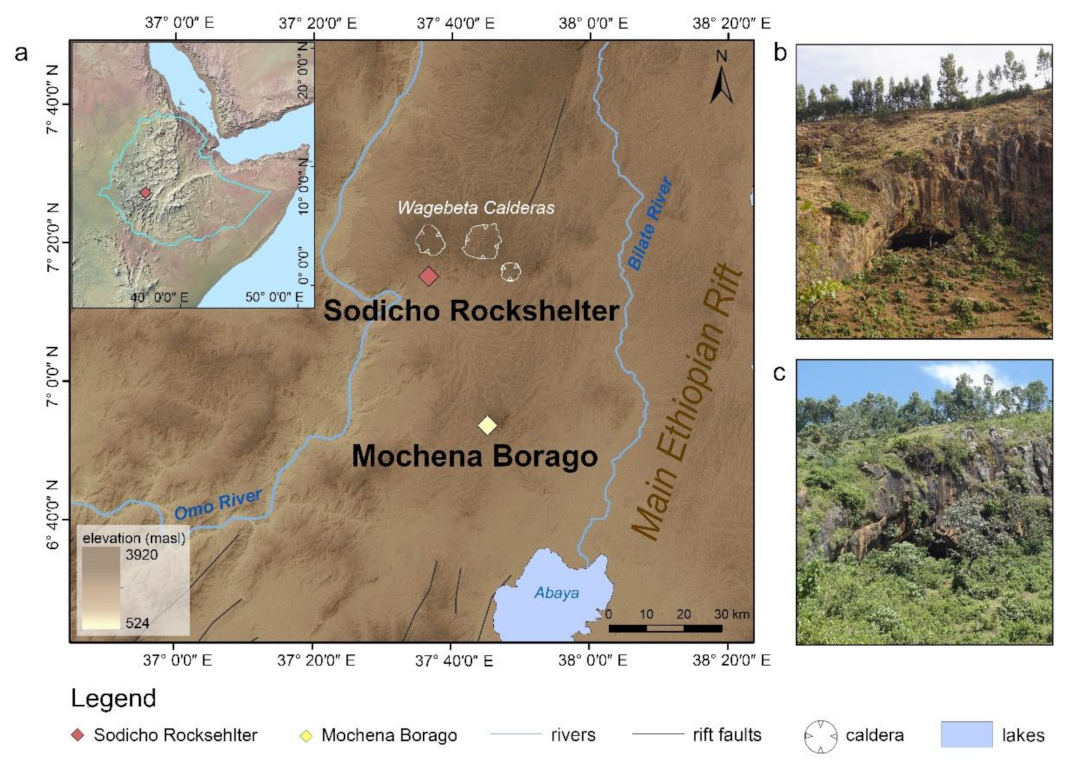
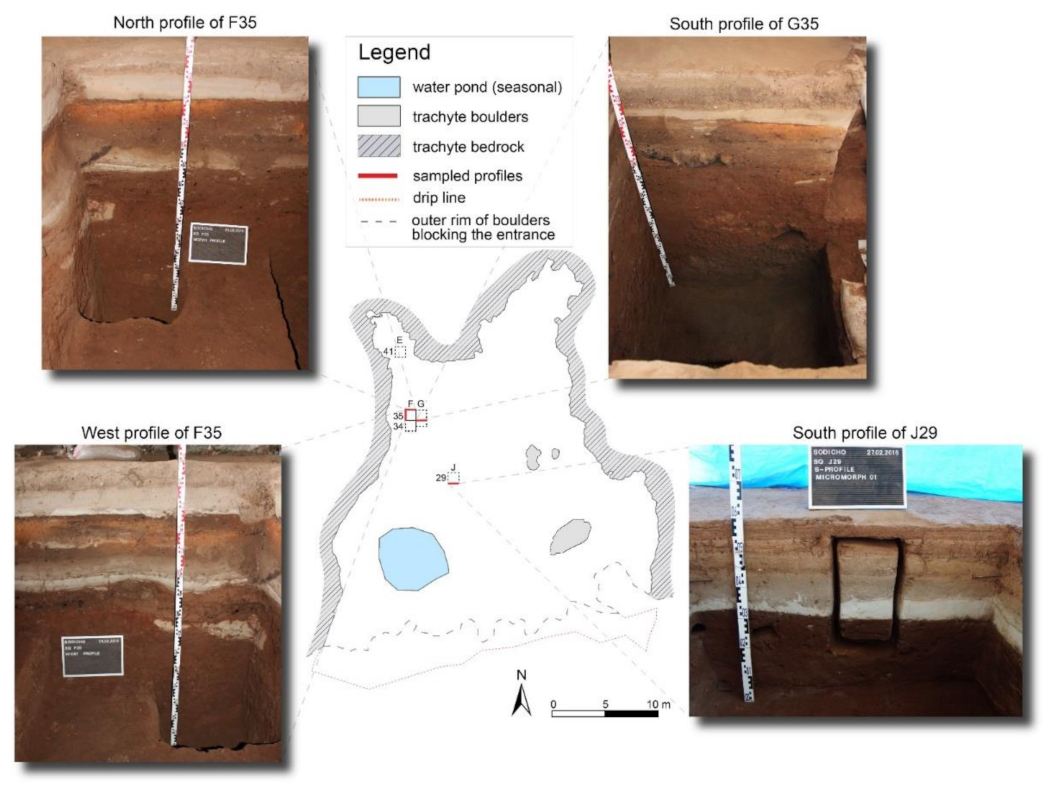
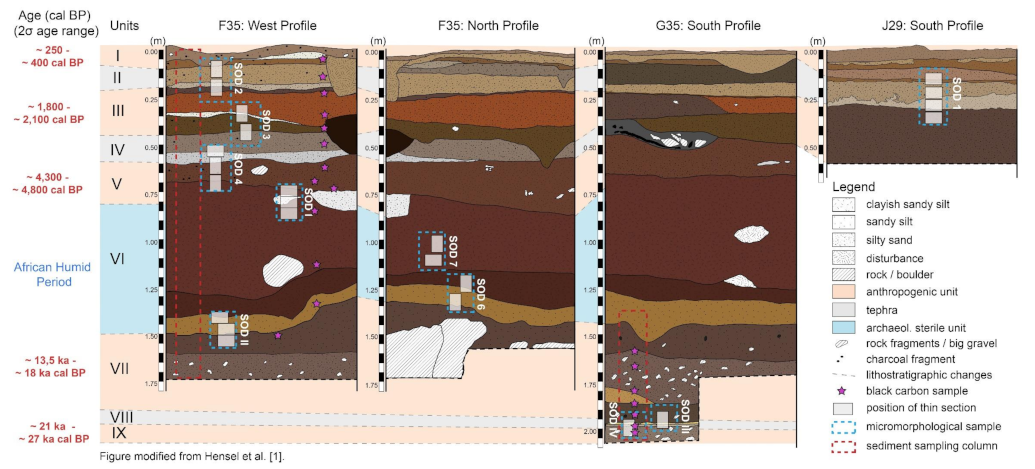
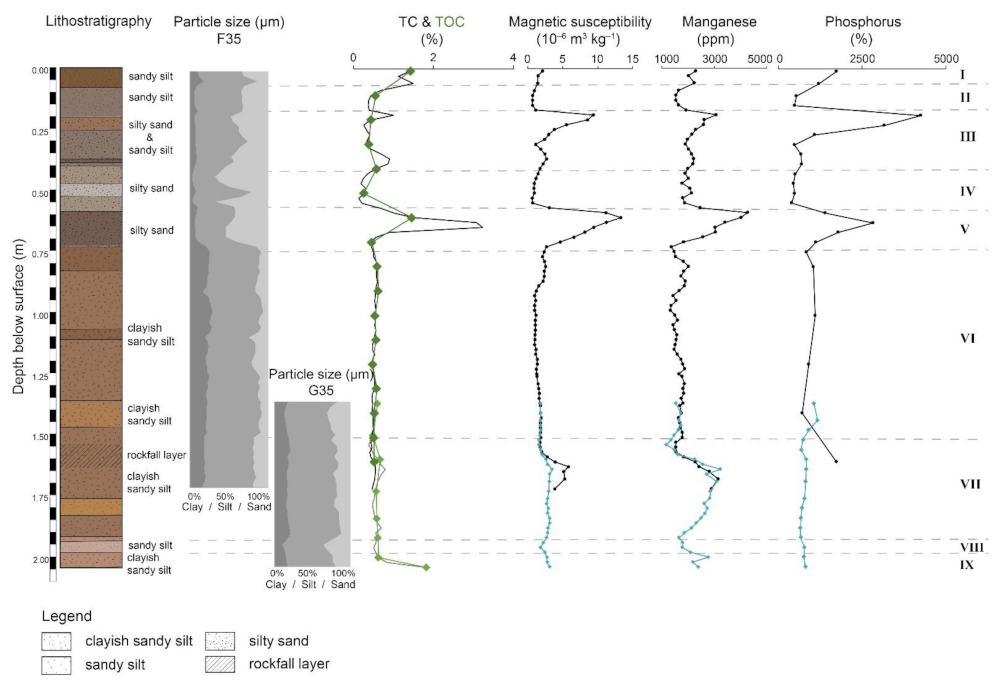
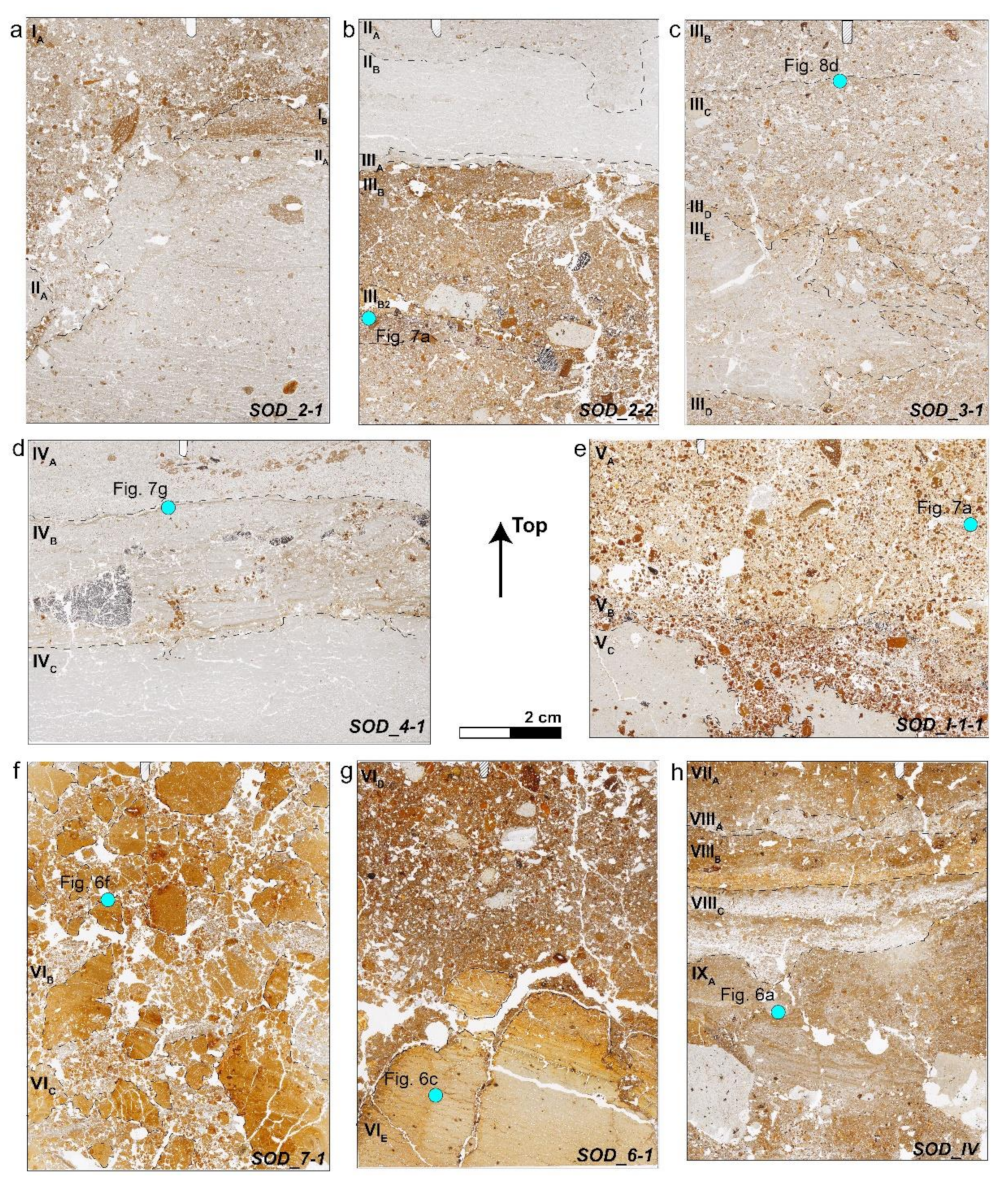
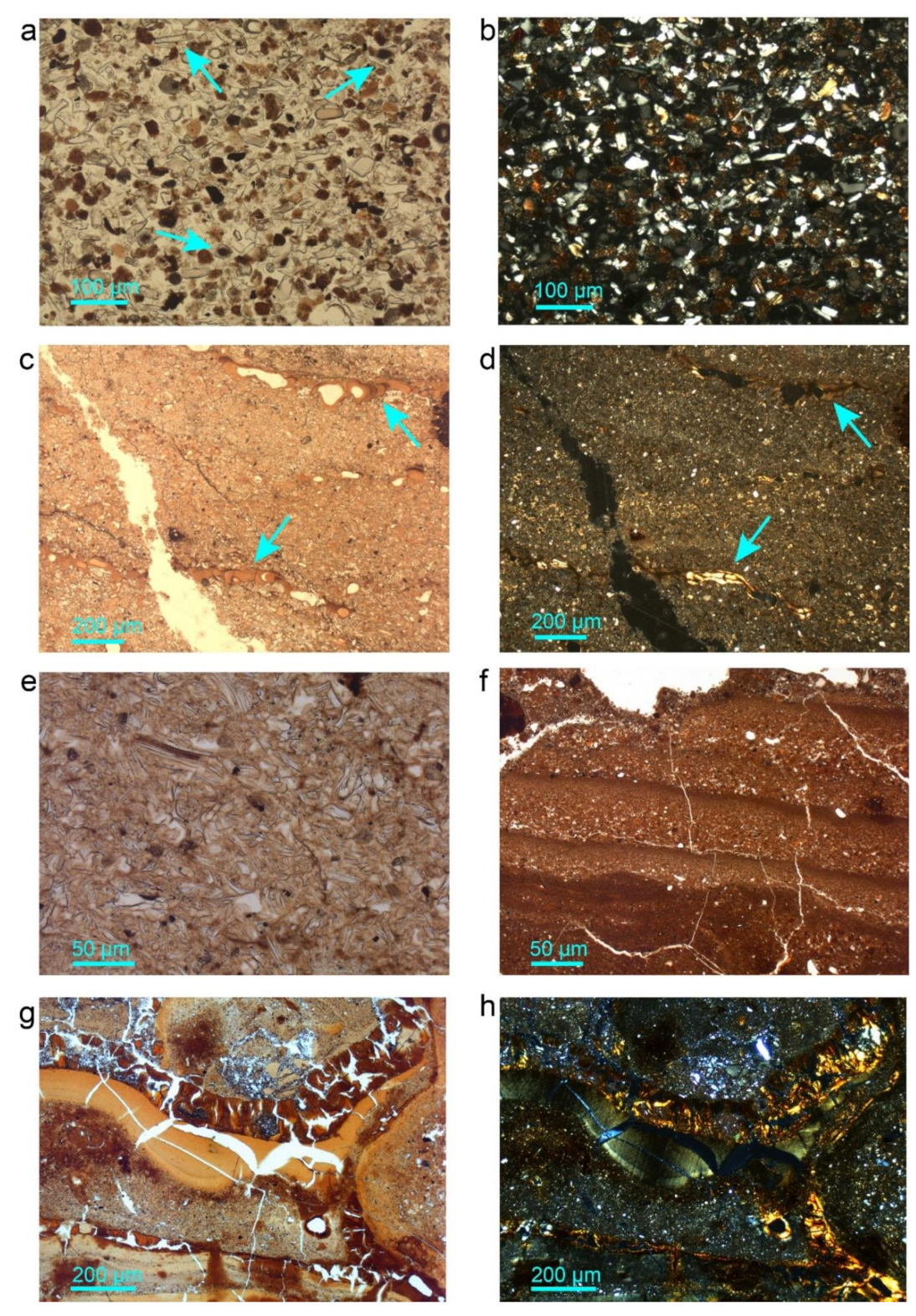


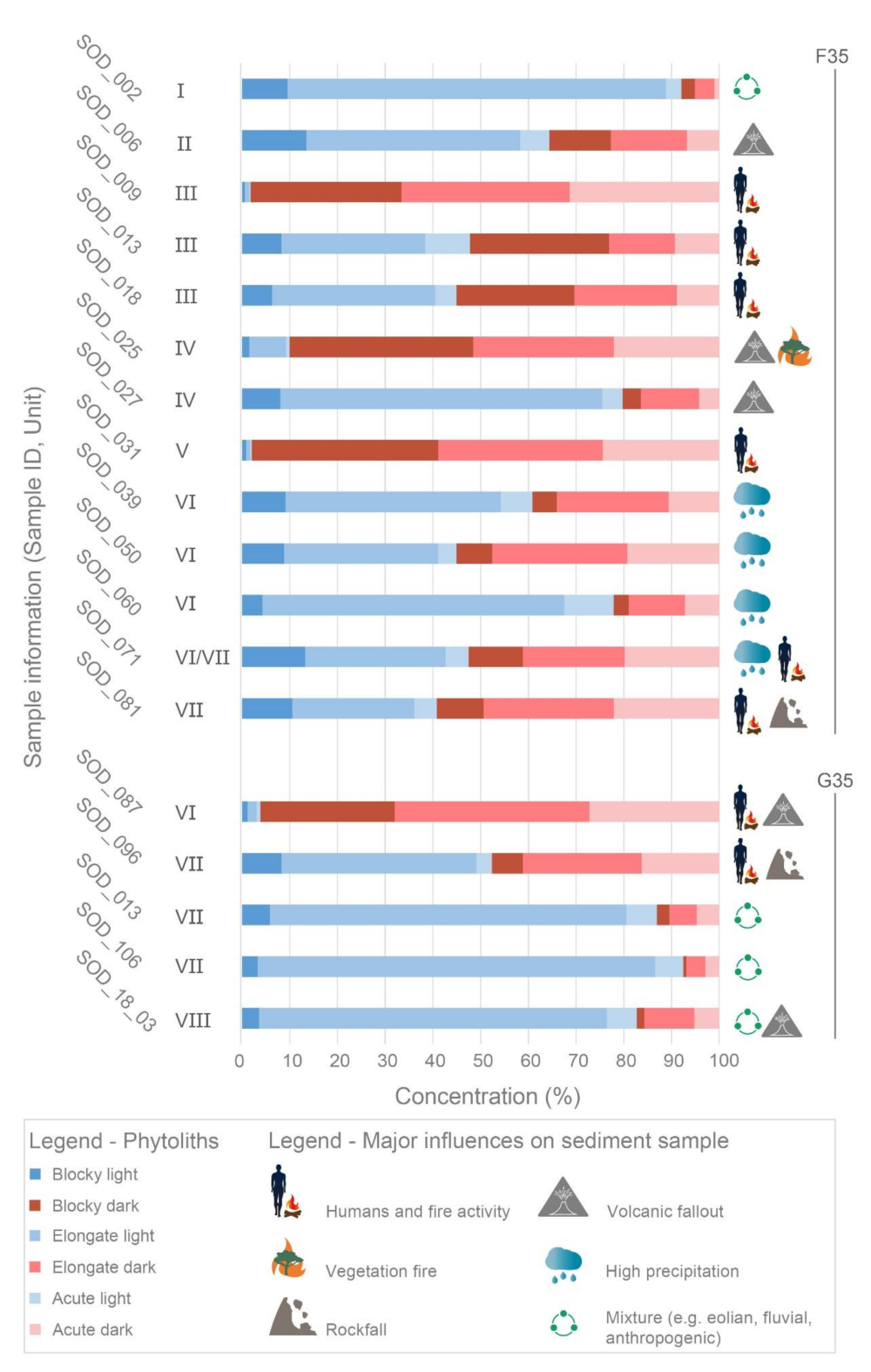
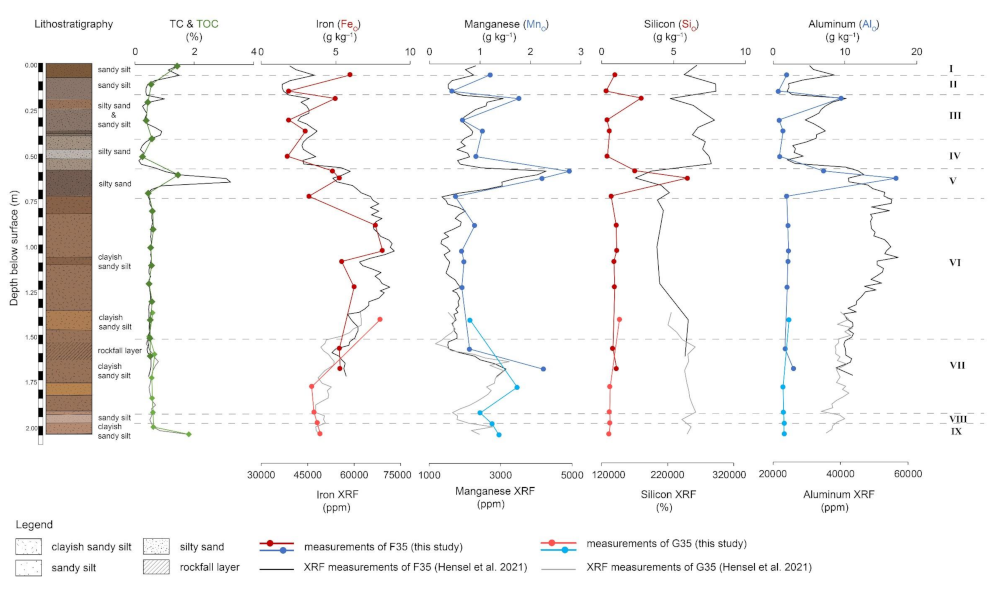
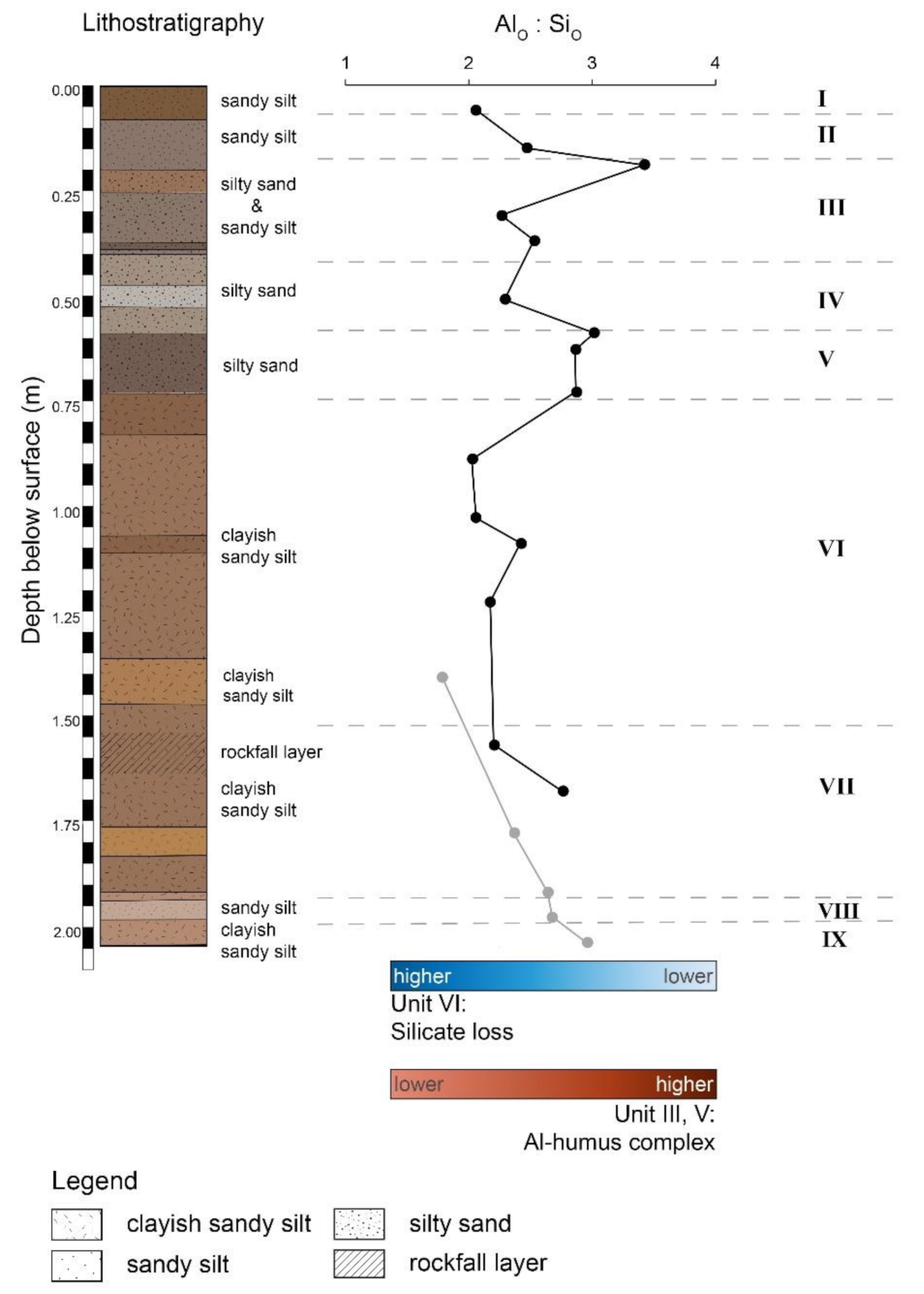

Publisher’s Note: MDPI stays neutral with regard to jurisdictional claims in published maps and institutional affiliations. |
© 2022 by the authors. Licensee MDPI, Basel, Switzerland. This article is an open access article distributed under the terms and conditions of the Creative Commons Attribution (CC BY) license (https://creativecommons.org/licenses/by/4.0/).
Share and Cite
Hensel, E.A.; Kehl, M.; Wöstehoff, L.; Neumann, K.; Vogelsang, R.; Bubenzer, O. A Multi-Method Approach for Deciphering Rockshelter Microstratigraphies—The Role of the Sodicho Rockshelter (SW Ethiopia) as a Geoarchaeological Archive. Geosciences 2022, 12, 92. https://doi.org/10.3390/geosciences12020092
Hensel EA, Kehl M, Wöstehoff L, Neumann K, Vogelsang R, Bubenzer O. A Multi-Method Approach for Deciphering Rockshelter Microstratigraphies—The Role of the Sodicho Rockshelter (SW Ethiopia) as a Geoarchaeological Archive. Geosciences. 2022; 12(2):92. https://doi.org/10.3390/geosciences12020092
Chicago/Turabian StyleHensel, Elena A., Martin Kehl, Luisa Wöstehoff, Katharina Neumann, Ralf Vogelsang, and Olaf Bubenzer. 2022. "A Multi-Method Approach for Deciphering Rockshelter Microstratigraphies—The Role of the Sodicho Rockshelter (SW Ethiopia) as a Geoarchaeological Archive" Geosciences 12, no. 2: 92. https://doi.org/10.3390/geosciences12020092
APA StyleHensel, E. A., Kehl, M., Wöstehoff, L., Neumann, K., Vogelsang, R., & Bubenzer, O. (2022). A Multi-Method Approach for Deciphering Rockshelter Microstratigraphies—The Role of the Sodicho Rockshelter (SW Ethiopia) as a Geoarchaeological Archive. Geosciences, 12(2), 92. https://doi.org/10.3390/geosciences12020092






